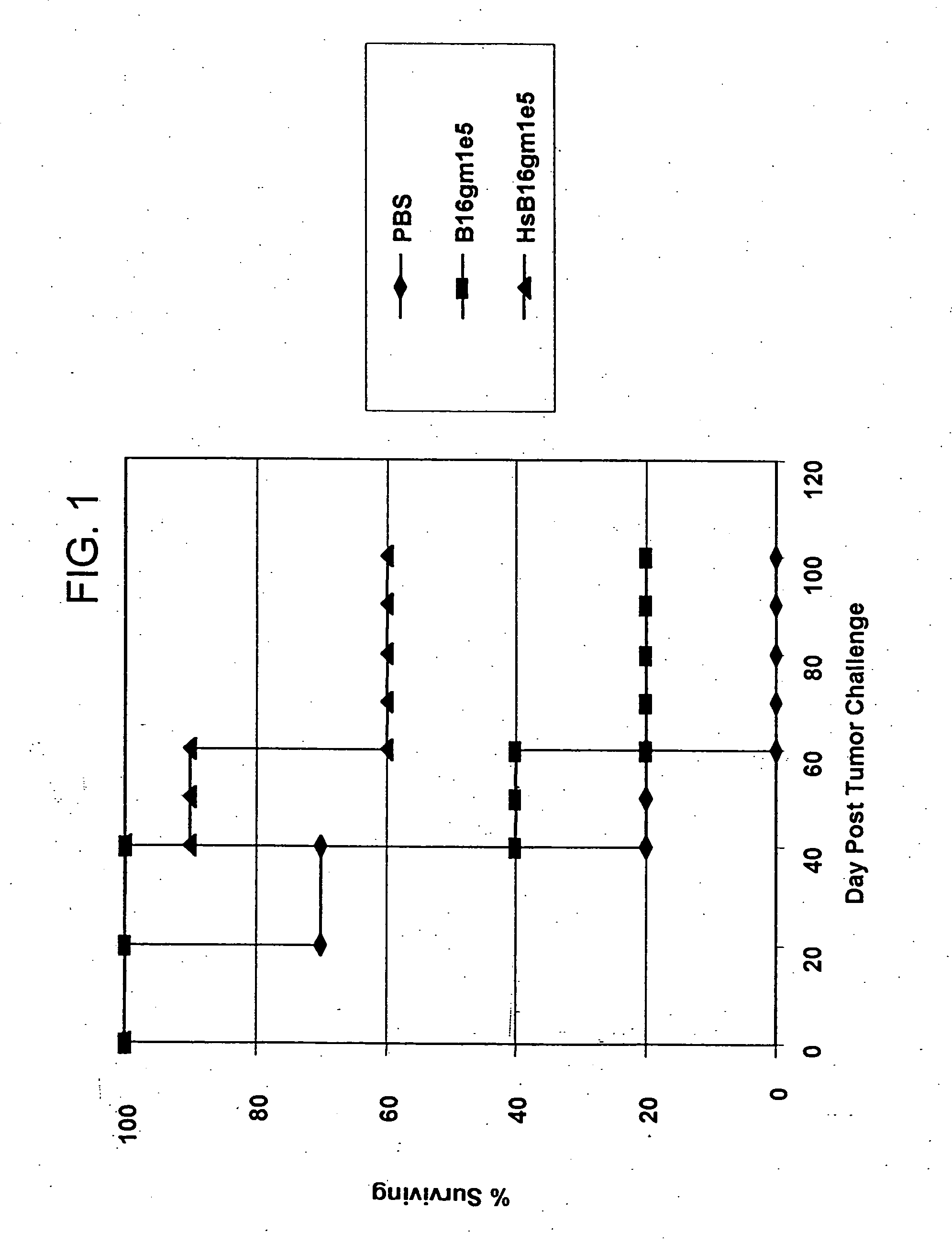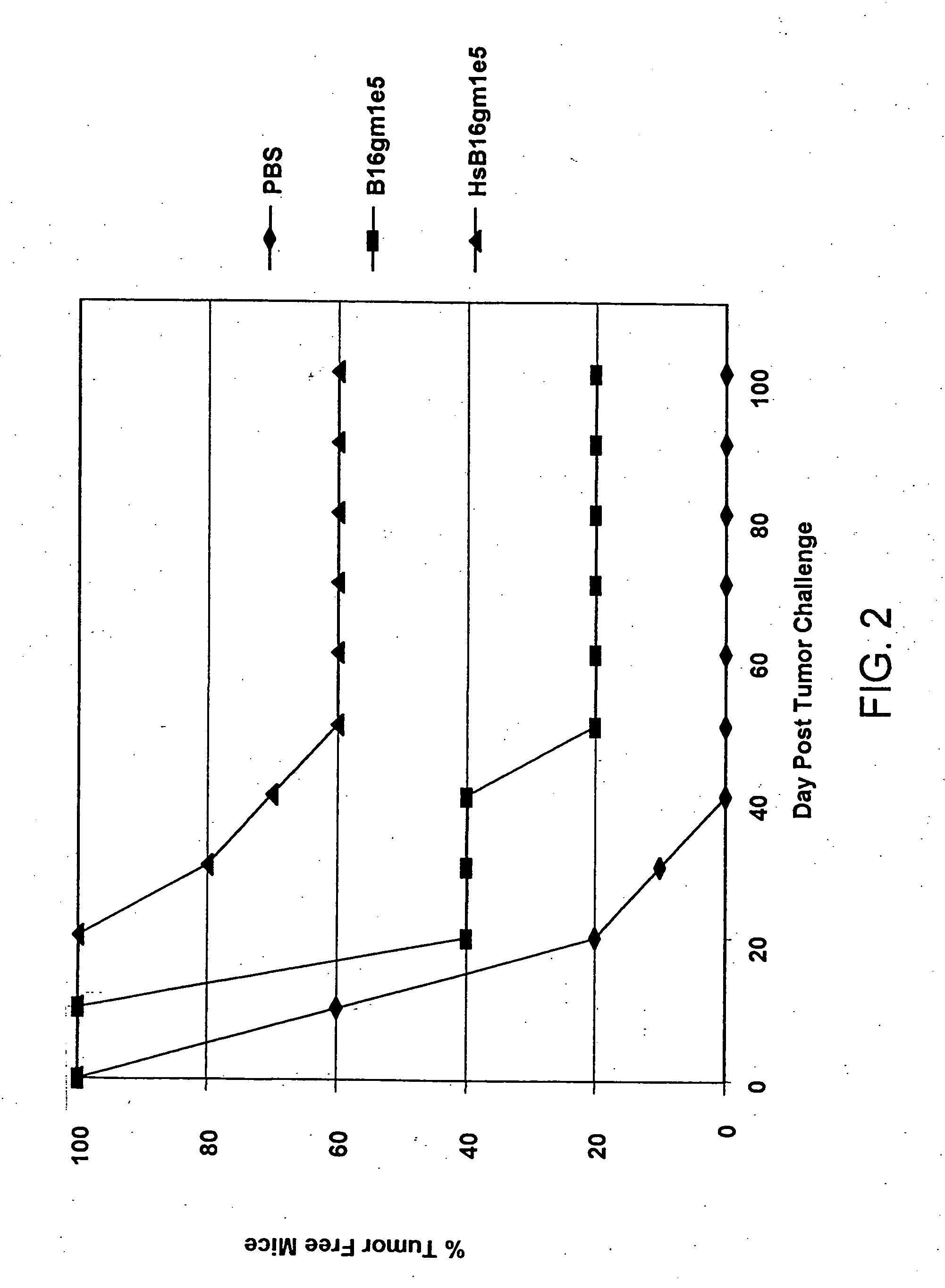Method for increasing tumor cell immunogenicity using heat shock protein
a technology of immunogenicity and tumor cells, applied in the field of tumor immunotherapy, can solve the problems of limited vaccine development, ineffective use of hsp for cancer immunotherapy, and inability to introduce a new gene into vaccine development, so as to reduce cancer cell growth, eradicate cancer in patients, and maximize cell delivery
- Summary
- Abstract
- Description
- Claims
- Application Information
AI Technical Summary
Benefits of technology
Problems solved by technology
Method used
Image
Examples
example 1
Induction of Endogenous Heat Shock Protein in HelaS3 Human Cervical Carcinoma Cells
[0048] HelaS3 cells used were commercially obtained from Cell Applications, Inc of San Diego, Calif. Cultures of HelaS3 cells (1-2×106 cells / mL) were harvested (trypsinization) and subject to a heat shock condition of approximately 44° C. for approximately 2 hours by immersion in a constant temperature water bath. Cells remained healthy after subjection to heat shock in this manner. The heat shocked cells were fixed (paraformaldehyde), permeabilized (Triton X-100 / BSA in TBS) and stained with FITC-conjugated mouse anti-h ihsp70. The expression level of induced ihsp 70 in the heat shocked cells was evaluated with fluorescence activated cell sorting (FACS) flow cytometry analysis against an isotype-matched control. Flow cytometry analysis for expression of ihsp70 was also performed for log phase HelaS3 cells in culture for more than 48 hours, and harvested HelaS3 cells plated back approximately one day ...
example 2
Induction of Endogenous Heat Shock Protein in PC3 and LNCaP Prostate Cancer Cells
[0056] PC3 cells and LNCaP cells were commercially obtained from BRFF of Ijamville, Md. PC3 prostate cancer cells and LNCaP prostate cancer cells were separately cultured and harvested in the manner described above for Example 1. The PC3 and LNCaP cells and were subject to heat shock treatment at 44° C. for 1 hour via immersion in a constant temperature water bath. Flow cytometry analysis results for harvested and replated cells, irradiated cells (5000 rads) and heat shocked cells (44° C. for 1 hour) are shown in Table 5.
TABLE 5PC3 / gmPC3 / gmPC3 / gmLNCaP / gmLNCaP / gmLNCaP / gmCellHarvestedIrradiatedheat shockHarvestedIrradiatedHeat shock%1308717436TotalGeo.5569587Mean
Constitutive hsp70 expression for PC3 and LNCaP cells were approximately 95% to 99% positive for all conditions. Inducible hsp70 increased approximately 14 fold (geometric mean) in heat shocked PC3 cells. In the case of the above prostate cell...
example 3
Induction of Endogenous Heat Shock Protein in B16 Melanoma Cells
[0057] B16 melanoma cells were prepared according to Vile et al., Cancer Res. 53:962 (1993). B16 melanoma cells were cultured and harvested in the manner described above for Example 1 and were subject to heat shock treatment at 44° C. for one half hour (30 minutes) by immersion in a constant temperature water bath. Flow cytometry analysis results for harvested and replated cells and heat shocked cells are shown in Table 6.
TABLE 6B16gmB16 / gmCellHarvestedHeat shocked% Total7.0683.56Geo. Mean29.8890.43
Heat shock treatment in this case provided an approximately 3-fold increase in ihsp70 expression in heat shocked cells over harvested cells, with greater than 90% ihsp70 expression in the heat shocked cells.
PUM
| Property | Measurement | Unit |
|---|---|---|
| diameter | aaaaa | aaaaa |
| temperature | aaaaa | aaaaa |
| temperature | aaaaa | aaaaa |
Abstract
Description
Claims
Application Information
 Login to View More
Login to View More - R&D
- Intellectual Property
- Life Sciences
- Materials
- Tech Scout
- Unparalleled Data Quality
- Higher Quality Content
- 60% Fewer Hallucinations
Browse by: Latest US Patents, China's latest patents, Technical Efficacy Thesaurus, Application Domain, Technology Topic, Popular Technical Reports.
© 2025 PatSnap. All rights reserved.Legal|Privacy policy|Modern Slavery Act Transparency Statement|Sitemap|About US| Contact US: help@patsnap.com



